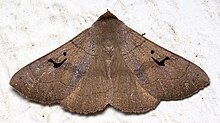Panopoda carneicosta
Appearance
| Panopoda carneicosta | |
|---|---|

| |
| Scientific classification | |
| Domain: | Eukaryota |
| Kingdom: | Animalia |
| Phylum: | Arthropoda |
| Class: | Insecta |
| Order: | Lepidoptera |
| Superfamily: | Noctuoidea |
| Family: | Erebidae |
| Genus: | Panopoda |
| Species: | P. carneicosta
|
| Binomial name | |
| Panopoda carneicosta Guenée, 1852
| |
| Synonyms | |
| |
Panopoda carneicosta, the brown panopoda, is a moth of the family Erebidae. The species was first described by Achille Guenée in 1852.[1] It is found in North America from Ontario, Quebec and Maine, south to Florida, west to Texas, north to Wisconsin and Minnesota.
The wingspan is 38–46 mm. Reported flight periods vary. Charles V. Covell Jr. gives a flight period of May to August, and Ohio State University gives a flight period of April to September. They are most seen in June and July though. There is one generation per year in the north, possibly two in the south.
The larvae feed on the leaves of basswood, oak, hickory and willow.
References
- ^ Savela, Markku (July 6, 2019). "Panopoda carneicosta Guenée, 1852". Lepidoptera and Some Other Life Forms. Retrieved January 26, 2020.
- Murray, Tom (July 21, 2018). "Species Panopoda carneicosta - Brown Panopoda - Hodges#8588". BugGuide. Retrieved January 26, 2020.
- "931090.00 – 8588 – Panopoda carneicosta – Brown Panopoda Moth – Guenée, 1852". North American Moth Photographers Group. Mississippi State University. Retrieved January 26, 2020.
